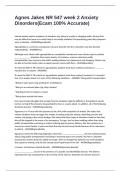Agnes Jakes NR 547 week 2 Anxiety
Disorders(Ecam 100% Accurate)
intense anxiety and/or avoidance of situations (eg, being in crowds or shopping malls, driving) that
may be difficult to leave or in which help is not readily available if incapacitating panic-like symptoms
were to develop - ANSWERAgoraphobia
Agoraphobia is a common consequence of panic disorder, but the 2 disorders can also develop
independently. - ANSWERTrue
Although some clients with agoraphobia are completely homebound, many clients cope by actively
______________ situations that create anxiety; for instance, a person who fears public
transportation may choose to live within walking distance to employment and shopping. Clients may
be able to function better when a support person comes with them - ANSWERavoiding
To meet the DSM-5-TR criteria for agoraphobia, patients must have marked, persistent (≥ ________
months) fear or anxiety - ANSWER6
To meet the DSM-5-TR criteria for agoraphobia, patients must have marked, persistent (≥ 6 months)
fear of or anxiety about 2 or more of the following situations: - ANSWER*Using public transportation
*Being in open spaces (eg, parking lot, marketplace)
*Being in an enclosed place (eg, shop, theater)
*Standing in line or being in a crowd
*Being alone outside the home
Fear must involve thoughts that escape from the situation might be difficult or that patients would
receive no help if they became incapacitated by fear or a panic attack. In addition, all of the following
should be present - ANSWERagoraphobia,
Sigourney is a 47-year-old who presents to the clinic with complaints of anxiety. She states that
certain situations seem to trigger her anxiety, including using the subway, attending concerts and
movies, and going to the corner bodega. She states that these types of situations make her fear that
she will be trapped in the event of an emergency. To cope, she has been walking rather than using
public transportation and using an online ordering app for grocery delivery. She has not been to a
concert or movie theater in years and feels that she has lost some friends because of her reluctance
to attend. - ANSWERagoraphobia,
Sigourney meets the following diagnostic criteria for ___________________: she has marked anxiety
about using public transportation and being in enclosed spaces and crowds. She fears a situation
because she worries about her ability to escape. She has changed her behaviors to avoid situations
that cause her anxiety, and she has caused social impairment in her life. - ANSWERagoraphobia:
a trauma- and stressor-related disorder - ANSWERAdjustment disorder
_________________ occurs in the presence of a specific and identifiable stressor. The distress
experienced is out of proportion to the severity of the stressor. Examples of common stressors
, include loss of employment, getting married, a new disability, or a natural disaster. Symptoms begin
within three months of the stressor and typically last no more than six months. -
ANSWERAdjustment disorder
Adjustment disorder symptoms begin within three months of the stressor and typically last no more
than __________ months. - ANSWERsix
A 32-year-old White male was formerly employed as a corporate lawyer and has recently started his
own business. He has started experiencing symptoms of intense anxiety when taking the subway to
work. The symptoms include feeling short of breath, chest pressure, sweaty, irritable, and an
impending sense of doom. The symptoms have persisted and worsened over time to where he has
everything delivered and cannot leave the house. What is the most likely diagnosis?
a. Malingering
b. Delusional disorder
c. Agoraphobia
d. Hypochondriasis - ANSWERAgoraphobia is characterized by a fear of open spaces and/or crowded
spaces, and often is co-morbid with panic disorder.
characterized by persistent, uncontrollable worry about ordinary, everyday situations. A pattern of
difficult to control, frequent excessive & persistent worry that occurs more days than not for at least
6 months - ANSWERGeneralized Anxiety Disorder (GAD) not due to substance misuse, medication, or
other medical/ mental condition
GAD often presents with physical symptoms, including: - ANSWER*restlessness or edginess
*fatigue
*difficulty concentrating
*irritability
*muscle tension
*sleep disturbance
Harold is a 32-year-old who presents to the clinic with complaints of fatigue, difficulty concentrating,
and difficulty falling asleep at night. He states he worries about finances, his performance at work,
and his relationship, and his worries have been "almost constant" for 8 months. He denies substance
use and recently had a normal physical exam. He feels that his relationship is suffering due to his
constant worry. - ANSWERGeneralized Anxiety Disorder
Harold meets the following diagnostic criteria for generalized anxiety disorder: He has three
symptoms associated with worry, including fatigue, difficulty concentrating, and sleep difficulties. He
has experienced anxiety more days than not for over 6 months, and his worries are impacting his
relationship.
GAD is associated with at least one of the following symptoms in children and at least three 3 of the
following symptoms in adults - ANSWER1. Restlessness
2. Easily Fatigued
3. Difficulty Concentrating




